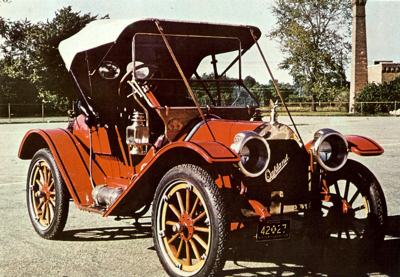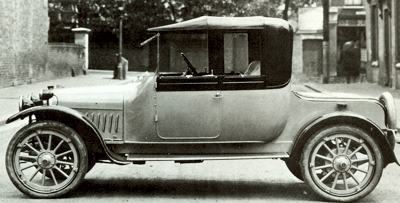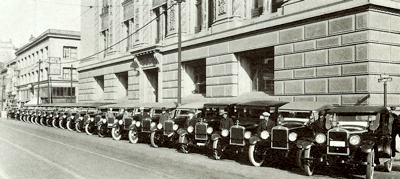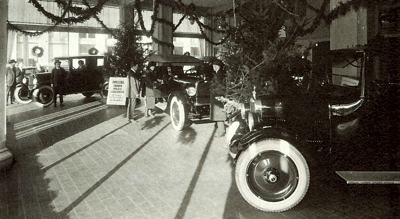The Car with a Conscience
Starting in a small way in 1908, Oakland steadily increased in output year after year until, for the fiscal year ending 31 July 1913, the gross receipts amounted to over ten millions of dollars. 'We have been able to make this progress because we have built honest, serviceable automobiles.' A company cannot thrive unless it does. 'In this commercial age, dealing as we do with a keen public, it is absolutely necessary to make every purchaser an 'asset' -a satisfied customer who is willing to recommend freely his choice to his friends. 'Goodwill is a priceless thing to have. 'The Oakland has it.'
As can be judged from the tone of this pre-World War 1 advertisement, the Oakland was hardly the most exciting vehicle to grace America's roads; indeed, its slogan 'the Car with a Conscience' is evidence that the marque relied more on soundness of construction than on original engineering.
Alanson P. Brush
The first car to leave the Oakland factory at Pontiac, Michigan (the town was named after a local Indian tribe), was a 20 hp, twin-cylinder runabout designed by Alanson P. Brush, who had previously designed the first Cadillac and the Brush Runabout. Weighing 1600lb and selling at $1375, the Oakland Model A had a two-speed epicyclic transmission and the engine cranked anti-clockwise (a supposed panacea for the risk of wrists broken by a backfire while the engine was being swung).
It was not, it seems, a great success, as by 1909 the Oakland company was in financial trouble: but that was the period when William Crapo Durant, having worked his way up from grocer's assistant, through mill worker, patent medicine pedlar, cigar salesman, estate agent and water works administrator to become the founder and owner of America's biggest carriage-building concern, was busy forming his General Motors Corporation to further his ambition of becoming the world's greatest motor car manufacturer of all time.
Oakland was sucked into the vortex of Durant's expanding organisation in 1909, the same year that the company began producing its first four-cylinder model, which had a conventional sliding-gear transmission, in place of the epicyclic unit. The company survived the fall of Billy Durant's first empire in 1910, and by 1912 was producing two four-cylinder models, of slightly over 3 and 4 liters respectively.
The following year a 40 hp six was added to the range. At Olympia in 1913 the Oakland company exhibited two cars, the 3136cc 15/20hp and the new 40hp, with a capacity of 5999cc. Specifications of these two models was broadly similar: their engines had pump water circulation, pressure-fed splash lubrication, Deleo electric lighting, starting and ignition system, three speeds forward, gate change, leather cone clutch and bevel final drive. The smaller model came complete with a five-seater body, was on a 9 ft 4 in wheelbase, while the 40 hp, on an 11 ft 4 in wheelbase and could be had in chassis form.
Switching to Left Hand Drive
Both cars had handsome vee-radiators similar to that of the Belgian Metallurgique, a pretty style that emphasised the marque's solid middle-class ambitions. A 5½-liter V8 became available in 1916, a year after the marque had adopted left-hand drive in response to growing demand (prior to 1916 most cars had right-hand-drive, particularly if they were considered up-market). Oakland then introduced their 15/20 hp small-bore six, which had a swept volume of 2955cc and overhead valves. It was an instant success: its low price of $795 prompted sales in excess of 35,000 the year after its inception, and soon Oakland had standardised the new six as its sole model.
 1911 Oakland Model A, powered by a 20hp twin-cylinder engine.
1911 Oakland Model A, powered by a 20hp twin-cylinder engine.
 1915 Oakland 4 export, with bodywork by Grosvenor.
1915 Oakland 4 export, with bodywork by Grosvenor.
 A line-up of Oaklands in 1923.
A line-up of Oaklands in 1923.
 Oakland showroom circa 1924. The sign in the background reads ... 'The Finest Light Six in the World'.
Oakland showroom circa 1924. The sign in the background reads ... 'The Finest Light Six in the World'.
|
The post World War 1 Oakland six's chassis specification was little changed from that of the 1913 model. Oaklands were built in the General Motors Canadian plant, too, for export to Britain, as this attracted a lower rate of import duty. The 1921 Oakland four-seater sports model sold in England for £540, though the only really sporting item of its specification was the adoption of wire wheels instead of the wooden artillery pattern used on the marque's staider models.
GM's Companion Make Program
As General Motors entered the 1920s, the product ladder started with the price-leading Chevrolet marque, and then progressed upward in price, power and appointments to Oakland, Oldsmobile, Buick and ultimately to the luxury Cadillac marque. By the mid 1920s, a sizable price gap existed between Chevrolet and Oakland, and the difference between an Oldsmobile and a Buick was wider. There was also a product gap between Buick and Cadillac.
To address this, General Motors authorized the introduction of four companion marques priced and designed to fill the gaps. Cadillac would introduce the LaSalle to fill the gap between Cadillac and Buick. Buick would introduce the Marquette to handle the upper end of the gap between Buick and Oldsmobile. Oldsmobile would introduce the Viking, which took care of the lower end of the same gap. This is often referred to as General Motors Companion Make Program.
For Oakland a new model was on the way, however, which appeared at the 1923 Olympia Motor Show. This had an engine of similar dimensions to the old six, but was equipped with side valves. A slight increase in bore size gave this model a capacity of 3038cc; it had pressure lubrication for the engine, which also supplied oil to the chassis lubrication points, a plate clutch and spiral bevel final drive. An advanced feature, but one shared by contemporary General Motors models, was the use of four-wheel brakes - though as these were the inefficient wrap-around band type, which were totally useless in the rain, and not much better in the dry, perhaps it wasn't such a bright idea after all.
Duco Quick-Drying Sprayed-On Lacquer
The handbrake acted on a drum on the transmission, a layout which made up in fierceness what it lacked in finesse, while there were now pressed steel disc wheels with detachable rims in the best 1920s American tradition. What was important about the factory-built 1924 Oakland bodies was their finish, using a new type of quick-drying sprayed-on lacquer instead of brushed paint or stove enamel. The new finish cut production time significantly, while retaining a high gloss - and it was a gloss that lasted, unlike varnish, which was liable to age very rapidly in service. The quick-drying lacquer was made by Duco, and had been partly developed by Charles F. Kettering, founder of the Dayton Engineering Laboratories Company - Deleo for short - whose 23 acre plant included a 300,000 sq ft 'think-tank' laboratory presided over by 'Boss Ket' (perfector of the electric starter for cars) himself.
Charles F. Kettering
Kettering had been inspired to develop a new type of paint for cars when he happened to look into the window of a jeweller's shop on New York's Fifth Avenue, and saw some little pin-trays finished in a new type of glossy lacquer. He rushed into the shop and asked who made them. The makers of the trays told him that a small laboratory in New Jersey supplied the lacquer. Kettering, who must by now have been fulfilling his popular image as 'a breathless seeker after knowledge', hurried over to New Jersey to buy a quart of the new finish. But the laboratory had never made as much as a quart of the lacquer. And when Kettering told the owner that he wanted to spray a car door with this material, he was told that the lacquer would be dry before it hit the car, and nothing could be done to slow down this process.
Dupont Viscolac
Undaunted, Kettering set about developing a compromise finish that would only take minutes to dry, 'halfway between the paint you couldn't speed up and the lacquer that couldn't be slowed down'. And that was what they used to paint the 1924 Oaklands. They called it Dupont Viscolac, and it was not long before use of similar finishes was universal throughout the car industry. Not that this innovation was to benefit Oakland in the long run. Sales were an impressive 58,000 in 1926, but that year the company introduced a new-low-priced running mate for the Oakland and called it the
Pontiac.
From that time on,the Oakland was living on borrowed time, as the
Pontiac looked as good a car as its parent, at less money. Oakland sales slumped to 30,826 in 1929, the last full year of the old side-valve six. A new model was launched the next season, another V8, this time based on the newly announced
Oldsmobile Viking. But the Viking was a flop, and so was the new Oakland. 1930 was hardly the right year to unveil a thirsty V8, even if it was moderately priced, and a year later the Oakland name vanished from the corporate roll of General Motors; henceforth all the cars to be produced in the Pontiac factory would bear the Pontiac name, taken from the Oakland's birthplace.
They had called the Oakland the car 'built for the man who demands proof'. And if the story of the Oakland proved anything, it was that worthiness of construction alone doesn't ensure a marque's continued existence; it needs the injection of a little excitement to catch the buying public's imagination and encourage that public to invest in a product.
